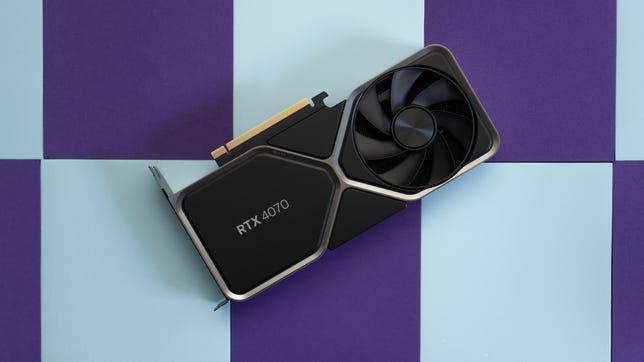Technologies
GeForce RTX 4070 GPU Review: It Hits the Bull’s-Eye of the Middle
From high 1080p gaming to low 4K, as well as for midrange graphics and video production, Nvidia’s RTX 4070 graphics card has got it covered.
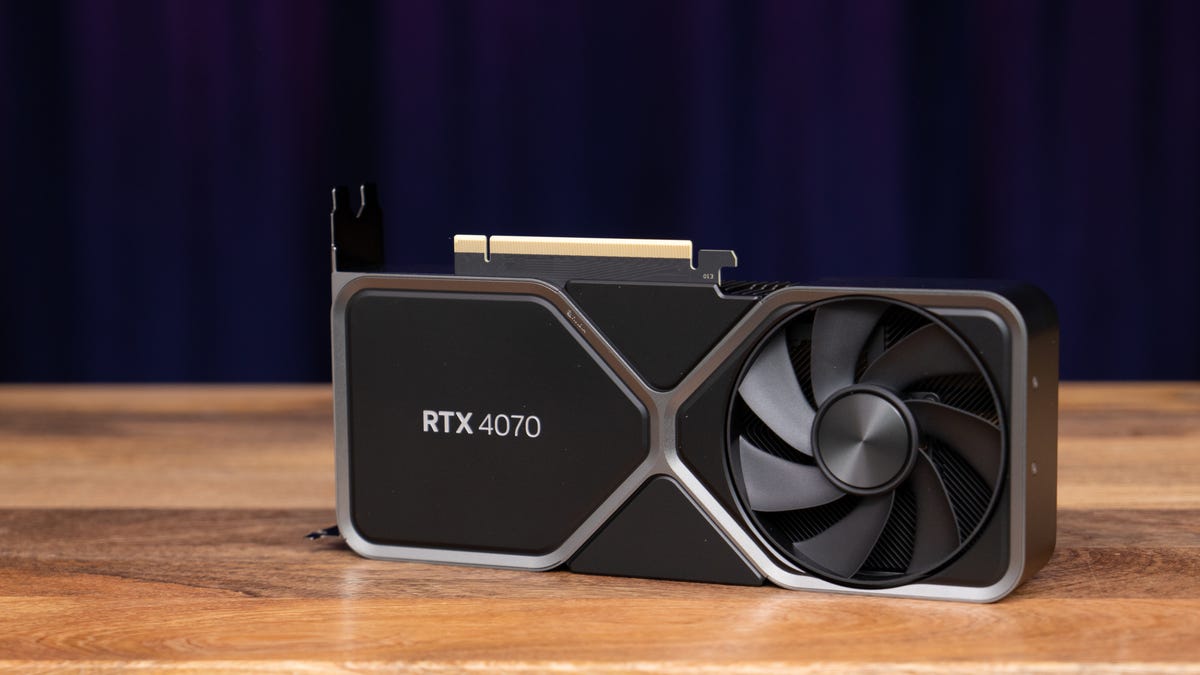
Nvidia’s latest throwdown in the GPU arena, the GeForce RTX 4070 seems like the most well-rounded meat-and-potatoes gaming card choice you can get — at least for the moment. It’s a first-rate option for upgrading to high-speed, highest quality 1080p through entry 4K gaming, hitting all of 1440p in between. Covering that much ground means you should be safe for a few years until you’re ready to upgrade again. It’s good for 4K video editing, most streaming and entry-level pro and AI-assisted graphics. The size and power requirements make it a good fit for midsize systems. And starting at $600, it’s the least expensive way to hit all those targets.
Like
- Well-rounded performance for the money
- Only takes two slots
Don’t Like
- Needs adapter or PCIe 5 power connectors
The step-up RTX 4070 Ti outperforms it, sometimes by quite a bit, thanks to its faster GPU clock and more cores across the board, which makes the 4070 Ti a tempting competitor for the same gaming performance classes as the RTX 4070. But it’s at least $200 more (although who knows what the 4070’s price range will settle at once the third-party boards start to ship on April 13), recommends a class higher of power supply and takes up more space. Though the 4070 Ti only needs a half-slot more width, that means it will block an entire second slot on many motherboards, and it might not even fit in some smaller systems.
Nvidia GeForce RTX 4070 Founders Edition
| Memory | 12GB GDDR6X |
|---|---|
| Memory bandwidth (GBps) | 504.2 |
| Memory clock (GHz) | 11 |
| GPU clock (GHz, base/boost) | 1.92/2.475 |
| Memory data rate/Interface | 21Gbps/192 bits |
| RT cores | 46 |
| CUDA Cores | 5888 |
| Texture mapping units | 184 |
| Streaming multiprocessors | 46 |
| Tensor Cores | 184 |
| Process | 4nm |
| TGP/min PSU (watts) | 200/650 |
| Max thermal (degrees) | 194F/90C |
| Bus | PCIe 4.0×16 |
| Size | 2 slots |
| Launch price | $600 |
| Ship date | April 12, 2023 |
AMD’s RX 7900 XT and RX 7900 XTX also outperform the RTX 4070, but they’re even more expensive than the RTX 4070 Ti and can’t keep up with the RTX 4070 for ray tracing. They’re also 2.5 slots thick like the 4070 Ti. And though it sounds tempting to opt for a last-generation GeForce model, they aren’t really cheaper unless you drop below an RTX 3070. But at that point you’ve also dropped down to a different performance class.
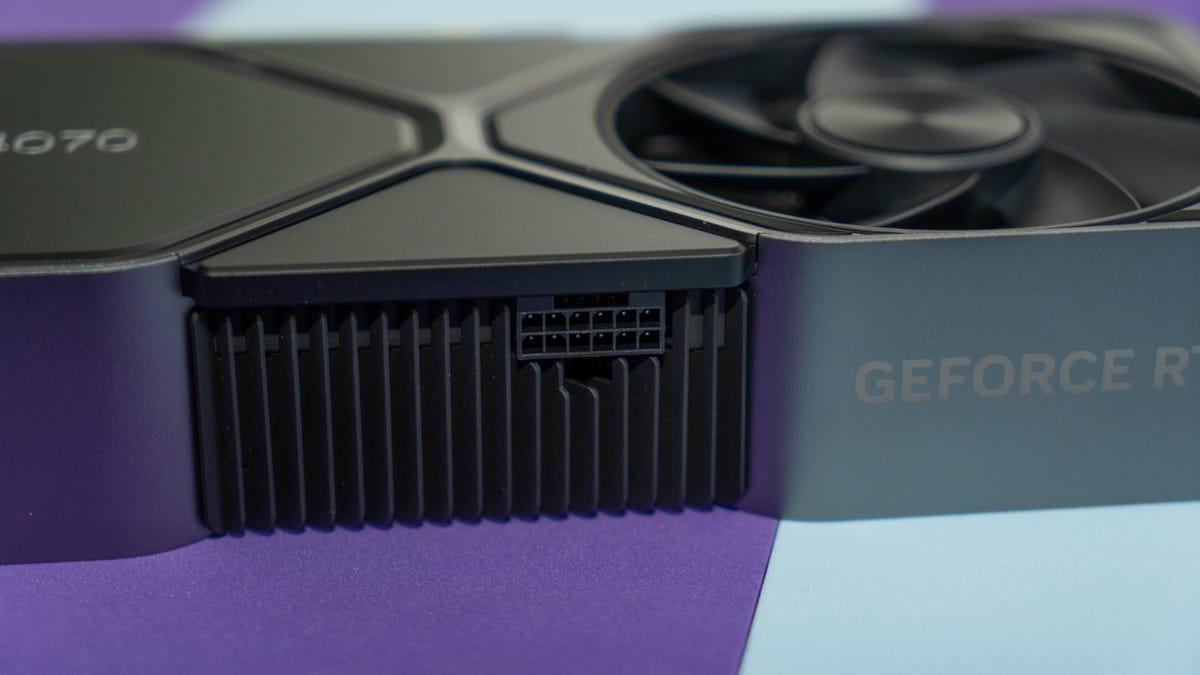

The RTX 4070 FE’s power connector.
Lori Grunin/CNETOne reason to go for an RTX 40-series class card over an older generation is the jump from DLSS 2 to DLSS 3, Nvidia’s performance optimization technology, that the newer Ada architecture made over Ampere. DLSS 3 delivers significant gains over its predecessor. The downside is that there aren’t a lot of DLSS 3-supporting games out yet — only about 50, which isn’t much out of the universe of thousands of games. But it does bump DLSS 2 performance over the RTX 30-series as well.
It was a bit odd that Nvidia didn’t release a home-grown Founders Edition of the 4070 Ti, but it returned to tradition with the 4070; the Founders Editions are notable for having guaranteed as-launched prices, though they also tend to sell out fast for that reason.
There’s little novel about the RTX 4070 FE’s design relative to the rest of the line. The one notable distinction is the power connector, which like the others needs either the bundled adapter or PCIe 5.0 PSU cables/adapters, but only uses a single 12-pin connection (rather than two).
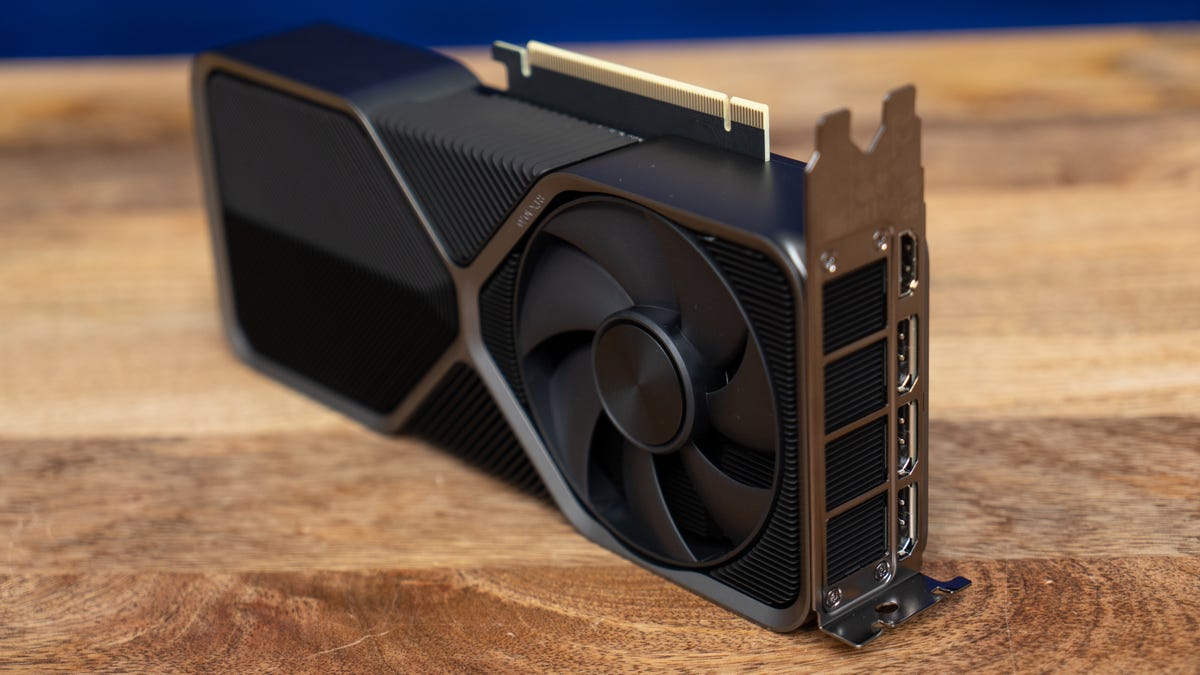

Like its siblings, the RTX 4070 FE has three DisplayPort 1.4 connections and one HDMI 2.1.
Lori Grunin/CNETCompanies release the highest priced, highest performing model, wait a little while to see how many people snap it up, then release a slightly cheaper, slightly less powerful model, rinse and repeat. And none do it more consistently than Nvidia. That makes offering informed buying advice harder than necessary: We know that slower, cheaper GPU models are coming, but not how much slower or how much cheaper.
I wouldn’t be surprised if there were a 4060 Ti in our future that makes an incremental drop that’s worth the performance sacrifice for the price savings, the way the RTX 4070 did subsequent to my review of the RTX 4070 Ti. But for the moment, the GeForce RTX 4070 seems to strike the best balance of performance for the money, and one that should keep you happy for a few years.
Relative performance of other GPUs
Shadow of the Tomb Raider gaming test (1440p)
Note:
Longer bars indicate better performance (FPS)
3DMark Time Spy graphics test
Note:
Longer bars indicate better performance
3DMark Fire Strike Ultra
Note:
Longer bars indicate better performance
Guardians of the Galaxy (1440p at maximum quality with ray tracing)
Note:
Longer bars indicate better performance (FPS)
Procyon Video
Note:
Longer bars indicate better performance
SpecViewPerf 2020 SolidWorks (4K)
Note:
Longer bars indicate better performance (FPS)
3DMark Speed Way (DX12 Ultimate)
Note:
Longer bars indicate better performance
3DMark DXR (DirectX Ray Tracing)
Note:
Longer bars indicate better performance (FPS)
Test PC configuration
| Custom PC | Microsoft Windows 11 Pro (22H2); 3.2GHz Intel Core i9-12900K; 32GB DDR5-4800; 2x Corsair MP600 Pro SSD; Corsair HX1200 80 Plus Platinum PSU, MSI MPG Z690 Force Wi-Fi motherboard, Corsair 4000D Airflow midtower case |
|---|
Technologies
Stay Informed About Your Flights This Holiday Season With Your iPhone’s Tracker
Your iPhone is hiding a flight tracker. Here’s how it works.
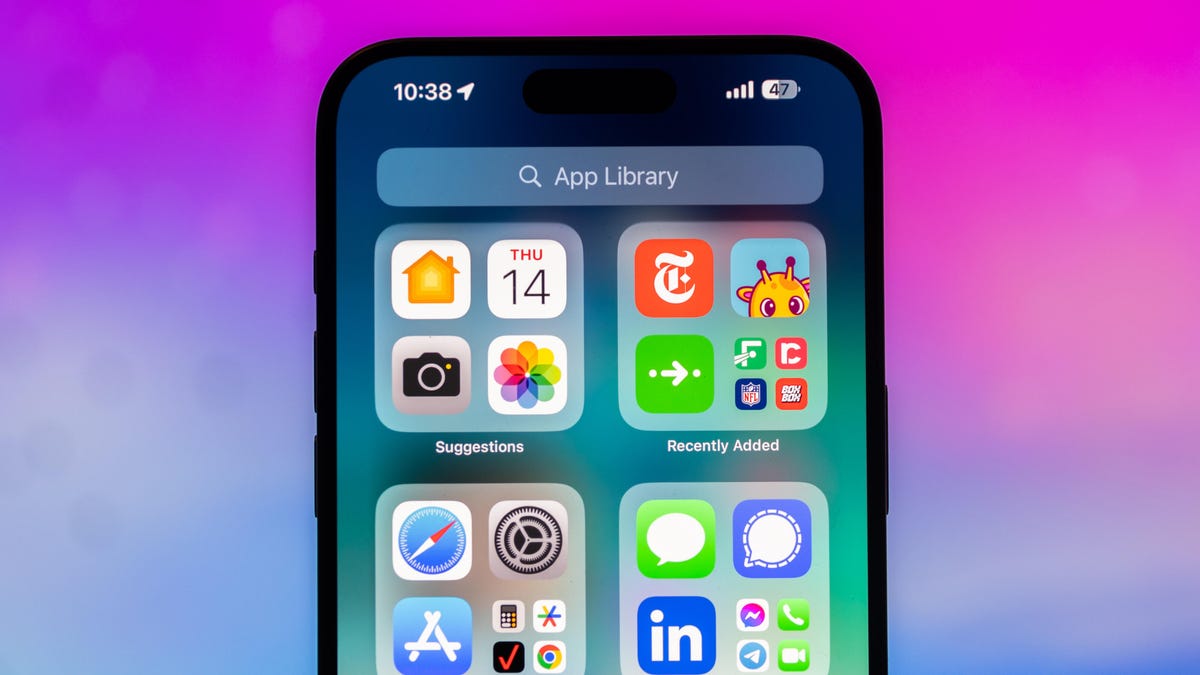
Thanksgiving is only a few short weeks away and if you plan on flying during the holiday season, keeping up-to-date on changes to your flights is crucial. Airports can be hectic during any holiday, but with the government shutdown continuing, flights are liable to change or be cancelled more often.
Luckily, it’s never been easier to get up-to-date information about your flight. For starters, your airline probably has an app, and if not, you can check its website. If you’re in a hurry, you can Google the flight number. Or you can just use your iPhone’s built-in flight tracker that’s sneakily tucked away.
That’s right: Your iPhone has a flight tracker that you may have never known about. It’s there for when it’s needed. Below, we’ll show you have to access it in not one, but two places, so you never have to go hunting for your flight info elsewhere again.
Don’t miss any of our unbiased tech content and lab-based reviews. Add CNET as a preferred Google source on Chrome.
For more on the iPhone, check out everything Apple announced at WWDC 2025.
How to track your flight via iMessage
Before we start, there are a few prerequisites you must meet:
- Make sure iMessage is enabled (it doesn’t work with SMS/MMS).
- You’ll need your flight number somewhere in your text messages, whether you’ve sent that information to someone (even yourself) or it’s been sent to you.
- The flight number must be sent in this format: [Airline] [Flight number], for example, American Airlines 9707.
Launch the native Messages app on your iPhone and open the text message thread that contains your flight information. You’ll know the flight tracker feature works when the text with the flight information appears underlined, which means it’s actionable and you can tap on it.
If your flight is still several months away or it’s already passed, you might see a message that says, «Flight information unavailable.» You might also see another flight that’s not yours because airlines recycle flight numbers.
You can check your flight status from Spotlight Search, too
If getting your flight information from Messages wasn’t easy enough, you can also grab the details right from your iPhone’s home screen by swiping down and adding your flight number into Spotlight Search. Even better, this works with Spotlight Search on your Mac computer, too.
How to access the hidden flight tracker
Although the airline name/flight number format highlighted above is the best way to go, there are other texting options that will lead you to the same result. So let’s say we stick with American Airlines 9707, other options that may bring up the flight tracker include:
- AmericanAirlines9707 (no spaces)
- AmericanAirlines 9707 (only one space)
- AA9707 (airline name is abbreviated and no space)
- AA 9707 (abbreviated and space)
I would suggest you keep the airline name spelled out completely and add a space between the two pieces of information — like in the previous section — because for some airlines, these alternative options may not work.
Real-time flight tracking
Once everything is set, tap on the flight information in your text messages. If the feature works correctly, you should see the following two options appear in a quick-action menu:
- Preview Flight: View the flight’s details. Tap this to view more information about the flight.
- Copy Flight Code: Copy the flight code to your clipboard (in case you want to send your flight details to someone else via text or email).
If you select Preview Flight, at the top of the window, you’ll see the best part of this feature: a real-time flight tracker map. A line will connect the two destinations, and a tiny airplane will move between them, indicating where the flight is at that exact moment.
Underneath the map, you’ll see important flight information:
- Airline name and flight number
- Flight status (arriving on time, delayed, canceled, etc.)
- Terminal and gate numbers (for arrival and departure)
- Arrival and departure time
- Flight duration
- Baggage claim (the number of the baggage carousel)
If you swipe left on the bottom half of the flight tracker, you can switch between flights, but only if there’s a return flight.
For more travel tips, don’t miss our test on whether AI can help you fly more sustainably.
Technologies
How to Get Verizon’s New Internet Plan for Just $25 Per Month
Technologies
This $20K Humanoid Robot Promises to Tidy Your Home. But There Are Strings Attached
The new Neo robot from 1X is designed to do chores. It’ll need help from you — and from folks behind the curtain.

It stands 5 feet, 6 inches tall, weighs about as much as a golden retriever and costs near the price of a brand-new budget car.
This is Neo, the humanoid robot. It’s billed as a personal assistant you can talk to and eventually rely on to take care of everyday tasks, such as loading the dishwasher and folding laundry.
Neo doesn’t work cheap. It’ll cost you $20,000. And even then, you’ll still have to train this new home bot, and possibly need a remote assist as well.
If that sounds enticing, preorders are now open (for a mere $200 down). You’ll be signing up as an early adopter for what Neo’s maker, a California-based company called 1X, is calling a «consumer-ready humanoid.» That’s opposed to other humanoids under development from the likes of Tesla and Figure, which are, for the moment at least, more focused on factory environments.
Neo is a whole order of magnitude different from robot vacuums like those from Roomba, Eufy and Ecovacs, and embodies a long-running sci-fi fantasy of robot maids and butlers doing chores and picking up after us. If this is the future, read on for more of what’s in store.
Don’t miss any of our unbiased tech content and lab-based reviews. Add CNET as a preferred Google source.
What the Neo robot can do around the house
The pitch from 1X is that Neo can do all manner of household chores: fold laundry, run a vacuum, tidy shelves, bring in the groceries. It can open doors, climb stairs and even act as a home entertainment system.
Neo appears to move smoothly, with a soft, almost human-like gait, thanks to 1X’s tendon-driven motor system that gives it gentle motion and impressive strength. The company says it can lift up to 154 pounds and carry 55 pounds, but it is quieter than a refrigerator. It’s covered in soft materials and neutral colors, making it look less intimidating than metallic prototypes from other companies.
The company says Neo has a 4-hour runtime. Its hands are IP68-rated, meaning they’re submersible in water. It can connect via Wi-Fi, Bluetooth and 5G. For conversation, it has a built-in LLM, the same sort of AI technology that powers ChatGPT and Gemini.
The primary way to control the Neo robot will be by speaking to it, just as if it were a person in your home.
Still, Neo’s usefulness today depends heavily on how you define useful. The Wall Street Journal’s Joanna Stern got an up-close look at Neo at 1X’s headquarters and found that, at least for now, it’s largely teleoperated, meaning a human often operates it remotely using a virtual-reality headset and controllers.
«I didn’t see Neo do anything autonomously, although the company did share a video of Neo opening a door on its own,» Stern wrote last week.
1X CEO Bernt Børnich told her that Neo will do most things autonomously in 2026, though he also acknowledged that the quality «may lag at first.»
The company’s FAQ says that for any chore request Neo doesn’t know how to accomplish, «you can schedule a 1X Expert to guide it» to help the robot «learn while getting the job done.»
What you need to know about Neo and privacy
Part of what early adopters are signing up for is to let Neo learn from their environment so that future versions can operate more independently.
That learning process raises privacy and trust questions. The robot uses a mix of visual, audio and contextual intelligence — meaning it can see, hear and remember interactions with users throughout their homes.
«If you buy this product, it is because you’re OK with that social contract,» Børnich told the Journal. «It’s less about Neo instantly doing your chores and more about you helping Neo learn to do them safely and effectively.»
Neo’s reliance on human operation behind the scenes prompted a response from John Carmack, a computer industry luminary known for his work with VR systems and the lead programmer of classic video games including Doom and Quake.
«Companies selling the dream of autonomous household humanoid robots today would be better off embracing reality and selling ‘remote operated household help’,» he wrote in a post on the X social network (formerly Twitter) on Monday.
1X says it’s taking steps to protect your privacy: Neo listens only when it recognizes it’s being addressed, and its cameras will blur out humans. You can restrict Neo from entering or viewing specific areas of your home, and the robot will never be teleoperated without owner approval, the company says.
But inviting an AI-equipped humanoid to observe your home life isn’t a small step.
The first units will ship to customers in the US in 2026. There is a $499 monthly subscription alternative to the $20,000 full-purchase price, though that will be available at an unspecified later date. A broader international rollout is promised for 2027.
Neo’s got a long road ahead of it to live up to the expectations set by Rosie the Robot in The Jetsons way back when. But this is no Hanna-Barbera cartoon. What we’re seeing now is a much more tangible harbinger of change.
-

 Technologies3 года ago
Technologies3 года agoTech Companies Need to Be Held Accountable for Security, Experts Say
-

 Technologies3 года ago
Technologies3 года agoBest Handheld Game Console in 2023
-

 Technologies3 года ago
Technologies3 года agoTighten Up Your VR Game With the Best Head Straps for Quest 2
-

 Technologies4 года ago
Technologies4 года agoVerum, Wickr and Threema: next generation secured messengers
-

 Technologies4 года ago
Technologies4 года agoBlack Friday 2021: The best deals on TVs, headphones, kitchenware, and more
-

 Technologies4 года ago
Technologies4 года agoGoogle to require vaccinations as Silicon Valley rethinks return-to-office policies
-

 Technologies4 года ago
Technologies4 года agoOlivia Harlan Dekker for Verum Messenger
-

 Technologies4 года ago
Technologies4 года agoiPhone 13 event: How to watch Apple’s big announcement tomorrow

